Mariculture in the Northern Territory
Mud Crabs
A detailed knowledge of the biology and ecology of an animal is essential for the succesful farming of that animal. Research by Government organisations and universities has been extremely important in the development of mariculture in Australia and around the world. The species of mud crab framed in the NT is Scylla serrata also known as the green or giant mud crab. Their shells vary in colour from dark blue-green to mottled brown. Mud crabs can be found in a large area including the northern half of Australia, the Philippines, the east coast of Africa and Pacific islands including Samoa and Fiji.
They can grow up to 25 cm long and weigh up to 3.5 kg but are usually sold between
weights of 500g to 1kg. They yield about 25% meat, largely from the front claws.
They hide in the muddy bottoms of estuaries and mangrove forests during the day and come out to hunt at night. The mud crab's back legs are flattened to help them swim. Mud crabs are opportunistic feeders; they are carnivores and herbivores, scavengers and cannibals. They will eat just about anything that they encounter, including bivalves, worms, fish, plant material and smaller crabs. Mud crabs use many senses to locate their food. Their eyes are on stalks, which allow them to see in every direction both in and out of the water. They also have a pair of antennae between their eyes that can detect minute changes in water movement and water chemistry. In addition, the tips of the legs (are covered in tiny hairs that are highly sensitive to touch and taste.
When eating food, mud crabs use their extremely powerful claws - the larger claw as a ‘crusher’ and the smaller claw as a ‘cutter’. Mud crabs also use their claws to defend themselves and can even drop a claw to facilitate escape. A new, fully functional claw will grow back in three to four months. |
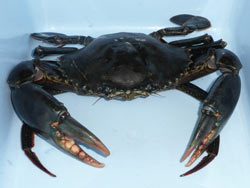
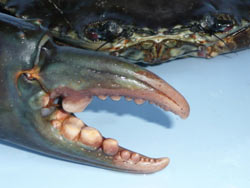
|
| |
|
Reproduction
The male can only mate with a female while her shell is soft, a period of about 48 hours after moulting. The male crab can sense when the female is about to moult and pairs up with her. He climbs on top of the female, clasps her with his legs, and carries her underneath him for up to four days. The male releases the female when she begins to moult and, when the process is complete, turns her upside down to mate.
When the female mud crab is ready to spawn, she creates a shallow hole in the sand or mud with her abdominal flap. She then releases her eggs into the depression and immediately begins to gather them up with a pair of her smaller legs. |

|
|
|
Mud crab eggs are bright orange when released and turn almost black by the time they are ready to hatch. The eggs are about 0.3 mm in diameter and a single batch may contain over two million eggs. While mud crabs produce large numbers of offspring, the mortality rate of larvae and juveniles is high. Hence, few crabs survive long enough to mate.
About 12 days after spawning, the eggs hatch, releasing the planktonic larval stage known as the zoea. Hatching is believed to occur offshore. The eggs take one to two hours to hatch, during which time the female stands on the tips of her legs and moves her abdominal flap back and forth in a motion that helps free the zoea.
At the first planktonic stage, the animal is just over 1 mm long. It increases in size by moulting four times over the next 12 to 15 days. During the fifth moult, the larval crab transforms into a megalopa with relatively large working claws. This stage lasts seven to nine days, during which the animal moves inshore and settles out of the plankton. The megalopa later moults into a stage one crab.
Stage one crabs are only about 4 mm wide, but frequent moults mean that they grow very quickly. It is thought that wild mud crabs grow to around 10 cm in width in about a year and become sexual mature in about two years. The typical life span of a mud crab is thought to be three to four years.
Biology and Reproduction of Mud Crabs adapted from Fishnote, No: 11 March 2007
The Life Cycle of the Mud Crab, M. Phelan and M. Grubert, Coastal Research Unit, Fisheries, Darwin |
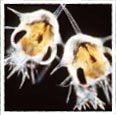
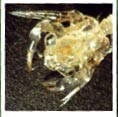
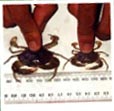
|
| |
|
| |
|
Mud crab farming
The people of the Kulaluk and Minmarama communities have developed the site of an unsuccessful small prawn farm within five minutes drive of Darwin’s Central Business District, at Coconut Grove into a Mud Crab farm. The site, on a natural mudflat, was unused for several years.
Mud crabs were selected as many believe that the species is over-fished and because the Darwin Aquaculture Centre (DAC), after ten years of research, now breeds larvae and grow them into juvenile crabs (crablets).
Currently the Kulaluk farm has four ponds holding 2.3ha of water. There are also three settlement ponds (total capacity of 0.5ha) providing for Environment Protection Authority-approved treatment of discarded water, a small hardstand shaded area, office, storage container and staff facilities.
Juvenile crabs are purchased for $0.20 each from the Darwin Aquaculture Centre hatchery at thumbnail size.
The farm’s pumps are operated on Spring tides - this provides for the least lift into the ponds and delivers the cleanest seawater. There are no issues with water quality providing the current zoning and use of the area in general isn’t changed.
The pond bases have been partially contoured to provide a more natural environment.
Some natural colonisition by the mangrove bush Avicennia marina provides an advantage by increasing food choices in the pond—detritus feeding—and by extending habitat choice.
Feed and growth
Stock feeding changes as the crabs grow. Initially they consume commercial food pellets. The pellet size is matched to the crab jaws’ width to help reduce fighting over food. As the stock grows the feed changes to pellets and fish mince, then to crushed/chopped prawns or fish. All live feeds are locally caught and tested to ensure they’re disease-free. Feeding is based on demand, and currently the farm staff are learning how the crabs respond. Growth rates are high, with 750 gram crabs produced in 145 days after stocking. |
The mud crab is one of the best seafoods to eat. Its moist meat, mostly found in the body and claws, has a wonderful distinct and sweet flavour.
Mud crabs can be steamed, boiled or poached in salted water, then seasoned with lemon, black pepper, garlic and onion. The crab can be finished off for the final dish by a variety of methods including barbecuing or pan-frying.
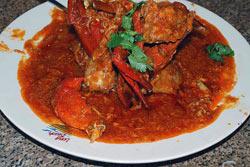
Mud Crab - Cooked ( Mackay Fish Market )
Price per Unit (Kg): $39.99 |
|
| |
|
Pond two holds 4,400 six-month-old crabs. Pond three has 24,000 juvenile crabs. and pond four has 22,000 juveniles at 4 months old.
Harvesting techniques are to still being developed and there are some complications to overcome. Currently pots are used and it can be difficult to remove the crabs from the mesh, since they may often hang on. More importantly, the crabs fight each other – and often the harvesters – ferociously and often lose limbs and claws which
seriously affects marketability. Each crab must be tied to prevent it using its claws.
It is hoped that eight tonnes of mud crab will be grown in the first year increasing to 15 tonnes with a market size of 350-450g per crab.
From Austasia Aquaculture, June 2008 |
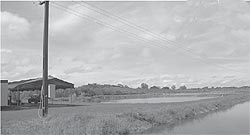
|
| |
|
Another pilot mud crab farming operation in Alyangula on Groote Eylandt was being developed in late 2009. Groote Eylandt is the largest island in the Gulf of Carpentaria in northeastern Australia. It is the homeland of, and is owned by, the Anindilyakwa people.
Groote Eylandt lies approximately 50 km from the Northern Territory mainland and eastern coast of Arnhem Land (approximately 630 km from Darwin). The island measures approximately 50 km from east to west and 60 km north.
Next: About Barramundi |
|